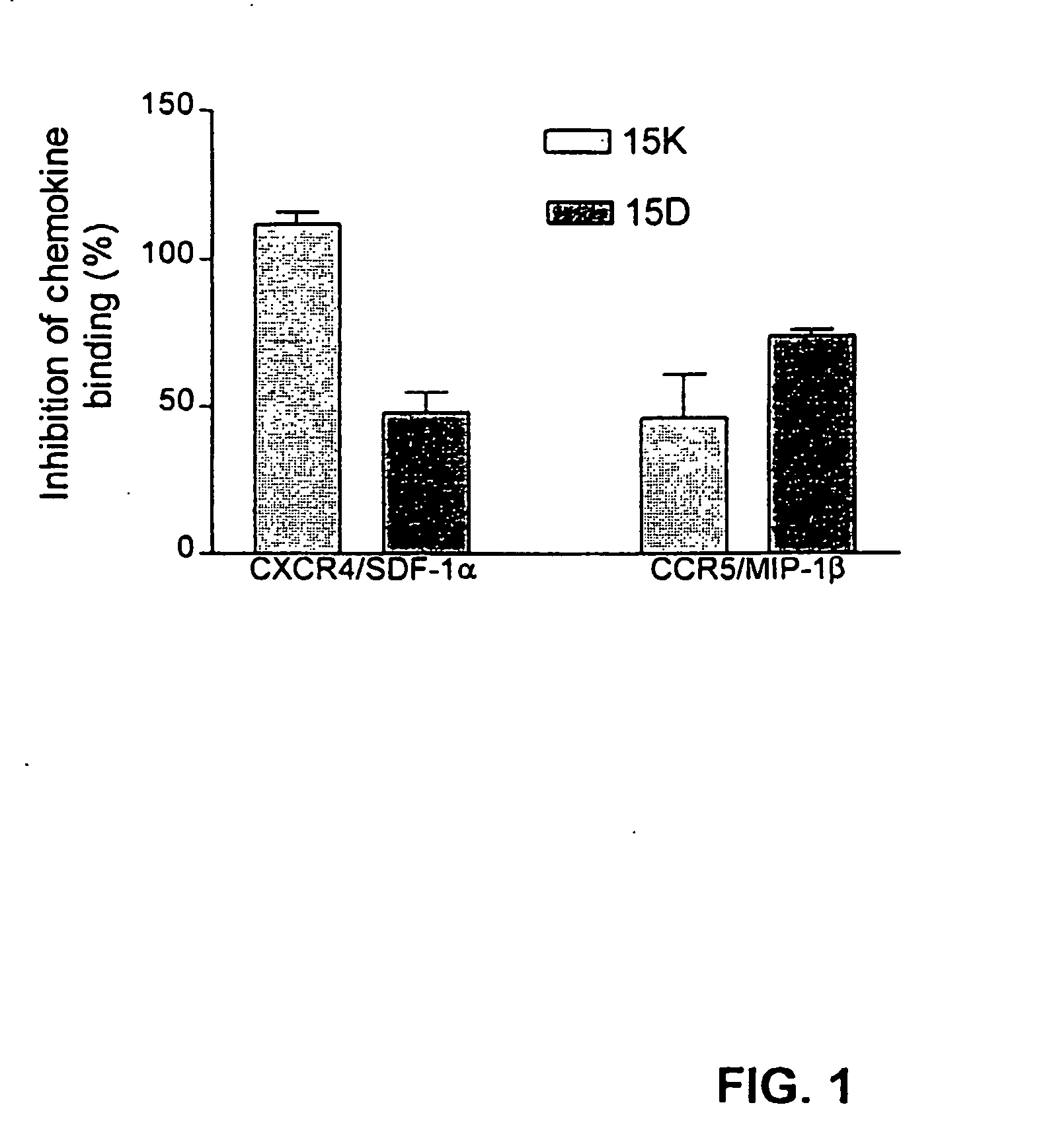Methods and compositions for inhibiting hiv-coreceptor interactions
a technology of coreceptors and compositions, applied in the direction of antibody medical ingredients, peptide sources, peptide/protein ingredients, etc., can solve the problems of incomplete understanding of virus tropism and env-chemokine receptor interactions, inability to teach or suggest identification of conserved binding determinants shared by gp120 and chemokines, and inability to disclose the nature of gp120 and chemokine interactions
- Summary
- Abstract
- Description
- Claims
- Application Information
AI Technical Summary
Benefits of technology
Problems solved by technology
Method used
Image
Examples
examples
Materials and Methods
[0185] The following examples describe computer modeling, synthesis and testing of co-receptor agents that inhibit the binding of HIV-1 to CXCR4 and CCR5.
Synthetic Peptides
[0186] Exemplary peptides 15D, 15K and 15KS, were synthesized using known methods by Macromolecular Resources (Fort Collins, Colo.), peptide 15CW was synthesized by the Basic Research Laboratory National Cancer Institute, (Frederick, MD). The peptides were purified by reverse-phase HPLC and the homogeneity of the peptide preparations was confirmed by mass-spectrometry.
Computer Modeling
[0187] Computer-generated structural models were derived using non-hydrogen atom superimposition of homologous residues during an optimization protocol of constrained consistent valence force field (CVFF) (Dauber-Osguthorpe et al., Proteins 4:31-47, 1988; Hagler et al., J. Am. Chem. Soc. 96:5319-27, 1974; and Hagler et al., Science 227:1309-15, 1985, each incorporated herein by reference), molecular dynam...
example i
Structural Analysis of gp120 and Chemokines
[0194] As noted above, a number of recent studies point to a role of chemokine receptors as coreceptors for HIV cell entry. Additional studies suggest that protein fragments or peptides from chemokines or HIV corresponding to structural determinants involved in chemokine receptor (coreceptor) binding, may be useful to block HIV-coreceptor binding and therefore serve as anti-HIV reagents. Considering that both chemokines and the HIV envelope protein gp120 are thought to directly interact with chemokine receptors, it is conceivable that this direct interaction may involve a part of the gp120 polypeptide chain that is structurally similar to (e.g., by homologous or convergent evolutionary relationship) receptor binding determinants of chemokines.
[0195] However, conventional amino acid sequence comparison between gp120 and chemokines undertaken by the present inventors did not reveal any significant amino acid identity or similarity relations...
example ii
Computer Modeling of gp120 and Chemokines
[0196] Computer modeling further demonstrates that novel peptide fragments of gp120 can be template forced onto a “homologous loop” of the known structure of an exemplary chemokine, MIP-1β without violation of the general rules of protein structure. To assess the possibility that a selected region of gp120 may potentially assume a structure similar to that of chemokines, a model of the corresponding structure of gp120 was built using the structure of MIP-1β (Lodi et al., Science 263:1762-1767, 1994, incorporated herein by reference) as the template. Based on this analysis, it was determined that a model of the three-dimensional structure of the selected gp120 segment could be generated without violation of protein stereochemistry. In an effort to examine the functional activity of this region, peptides corresponding to the selected gp120 sequence were synthesized for further studies.
PUM
| Property | Measurement | Unit |
|---|---|---|
| Temperature | aaaaa | aaaaa |
| Fraction | aaaaa | aaaaa |
| Length | aaaaa | aaaaa |
Abstract
Description
Claims
Application Information
 Login to View More
Login to View More - R&D
- Intellectual Property
- Life Sciences
- Materials
- Tech Scout
- Unparalleled Data Quality
- Higher Quality Content
- 60% Fewer Hallucinations
Browse by: Latest US Patents, China's latest patents, Technical Efficacy Thesaurus, Application Domain, Technology Topic, Popular Technical Reports.
© 2025 PatSnap. All rights reserved.Legal|Privacy policy|Modern Slavery Act Transparency Statement|Sitemap|About US| Contact US: help@patsnap.com



